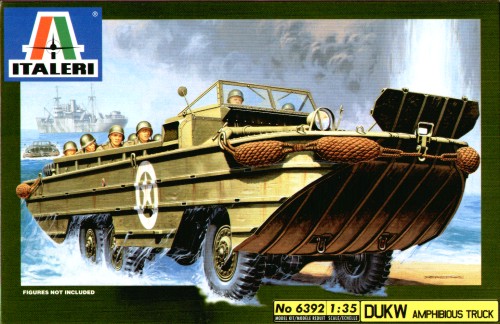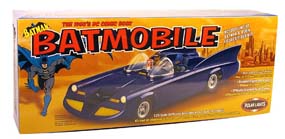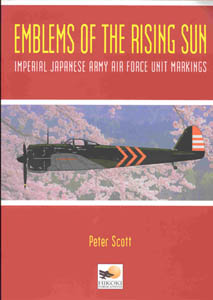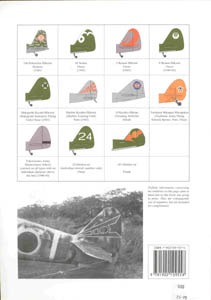SCALEWORLD By Richard Marmo | | It's 2003. Happy new year! Now, can someone tell me where 2002 went? Seems like only last month I was writing another January column! Oh, well, the old year's gone, the new year's here and you're trying to figure out what to do with all that Christmas money that's burning a hole in your pocket. You know what I'm talking about…the checks and cash you received from people who didn't have a clue as to what kind of gift to buy you, assuming they thought about buying you a gift at all. So, they threw a wad of cash at you and said "Buy your own!". Since we're model builders, our thoughts naturally turn to model kits. Right? Well, consider the following:
First up is a kit that armor enthusiasts should be happy to spend their money on…a 1/35th scale DUKW from ITALERI (https://www.testors.com). Price? $35.00. Besides being a subject that has long been wanted, it will fill a very prominent gap in comprehensive armor. All I can say is "Italeri, why did you wait so long?".
Since the DUKW is essentially nothing more than a GMC 2 1/2 ton 6x6 truck wrapped in a flotation hull, the finished model runs nearly 11" in length. As a result, the conventional top over bottom box is some 14" long. Once into the box, you find three sprues of olive drab parts and one of clear. Nothing is bagged. Total parts count is 144, with decals and instructions completing the package. 
Anyone who's ever built an ITALERI armor kit knows what to expect. Parts are crisp and clean with few injector pin marks to cause a problem. Some of the smaller parts lean towards the delicate side as they should, which means be very careful with the sprue cutter or Xacto knife when separating them from the sprue. The hull is comprised of four parts…top, bottom and sides. Instructions have you wait til step 7 to assemble these parts, after all those nice delicate parts have been mounted on the top. Personally, I'd assemble the hull first pop out of the box, clean up the seams if necessary and then start adding everything else. And, of course, the tires should be the last thing to be installed. As far as the instructions are concerned, they're more vintage ITALERI. Large, clear and with illustrations only. Detail colors are indicated in the various steps by small black circles with letter codes. One page of the instructions provides you with three different sets of four-view drawings as an aid to camouflage and markings. Two are Army vehicles, one with markings that place it at Normandy on D-Day and the other in Germany during 1945. Both are overall O.D. and the only thing that changes are the markings. The most interesting one of the bunch, and the decal sheet includes the proper markings, is a Marine DUKW at Iwo Jima in 1945 wearing green, tan and sand camouflage. If you're looking for a break from monotone O.D. schemes, here's your chance. Now, there are a few things that you don't get in the DUKW kit. Figures for one, with the boxtop prominently specifying that fact. You also don't get any kind of a cargo load, canvas cover or cover support bows. But hey, isn't that why we're modelbuilders? So we can take an excellent basic kit and then add all the extra touches? Sure, you can build it straight out of the box and sit it on a bare shelf. But wouldn't it look a lot better in a diorama fighting it's way thru pounding surf with a full load of cargo and troops? Absolutely. Only one question remains. Who's going to be first to do it?
Moving from fact to fantasy, those of you with fond memories of DC Comic Books from the 1960s, specifically Batman, should welcome one of the latest releases from POLAR LIGHTS (https://www.polarlights.com) with open arms. Namely a Batmobile that replicates the one used by our courageous Batman & Robin crimefighting team in the pages of the 1960s vintage Batman comic books.

The kit comes packed in a colorful top over bottom box that is crammed with seven bags of parts in black styrene. As is now POLAR LIGHTS' standard practice, one out of every twelve kits are molded in white and a little clear oval window on the bottom allows you to see what color is in your kit. With some 113 parts (the boxtop says over 110) and a decal sheet, this kit is rated for age 10 to adult. In other words, for all practical purposes, it's a level 3. Everything is cleanly molded with little, if any, flash. Detail is excellent, including a complete engine that begs for additional superdetailing. In case you're wondering how far you can take things, keep in mind that you get a separate frame that mounts to the floor pan. Even the twin exhaust pipes are separate and the interior detail is complete. You don't just get the Batmobile. Included are a set of Batman & Robin figures (seven pieces each) that are posed as occupants in the car with Batman driving. There won't be any problem making them look just like the 'real' Batman & Robin in the comic book. Instructions are the usual retro style with very clear illustrations and extensive text descriptions. Painting suggestions go into considerable detail and even tell you when certain areas never had any definitive colors in the comic book…meaning that it's modeler's choice there. That makes the instruction sheet sound like it has a lot crammed into it and it does…all on one side. The flip side duplicates the construction information…in French. Not bad at all for a kit that only carries a $17.99 price tag.
If you prefer books and your interest lies with WW-II Japanese Army Air Force, then you need to definitely consider a new publication from HIKOKI PUBLICATIONS. Emblems Of The Rising Sun - Imperial Japanese Army Air Force Unit Markings by Peter Scott is an absolute must for your WW-II Japanese reference shelf.
 Utilizing a 9" x 12" format, you get 128 pages of glossy enamel stock inside of semi-stiff covers. What you get is 104 pages of color drawings, 88 b&w photos of J.A.A.F. aircraft and a bunch of organizational charts. Utilizing a 9" x 12" format, you get 128 pages of glossy enamel stock inside of semi-stiff covers. What you get is 104 pages of color drawings, 88 b&w photos of J.A.A.F. aircraft and a bunch of organizational charts.
The avowed purpose of this book is specifically IJAAF unit markings and that's exactly where it stays. A fairly brief introduction (seven pages) discusses unit organization and such things as stripes, combat bands, tactical markings, the hinomaru. Camouflage is given a very brief amount of space, the reader instead being referred to existing and planned publications that focus primarily on camouflage. A solid 31 pages is devoted to nothing but color drawings of aircraft aft fuselage/vertical tail surfaces. If, for example, you wanted to know what the tail markings were for the 3rd Chutai of the 208th Sentai, it's here. At the same time, you'll find out that the aircraft was a Lily and that particular marking was used from 1941-1945. The same pattern is followed for the Dokoritsu Chutai, Rensei Hikotai and on and on. In fact, the back cover of the book (reproduced here - I hope) is an excellent example of what you'll find on each of those pages.  The next 57 pages throw 172 color profiles of various aircraft at you, complete with camouflage schemes. Since they're only profiles, you'll either have to make assumptions as to the upper and lower surface colors or do additional research. There are some truly unusual aircraft and schemes here. For example, a Mitsubishi Ki-2-1 Louise in a 3-tone camouflage from 1937. How about three different unit markings for a Tachikawa Ki-9 Spruce? And if you want something really different, check out the captured Curtiss P-40E that was found by Allies at Yokota, Japan in 1945. Guns and radio had been stripped and it displayed a white outlined Hinomaru painted over the original red center star-in-circle U.S. insignia. By the time it was found in 1945, the Hinomaru had faded to the point that the U.S. marking was showing thru the red paint. The next 57 pages throw 172 color profiles of various aircraft at you, complete with camouflage schemes. Since they're only profiles, you'll either have to make assumptions as to the upper and lower surface colors or do additional research. There are some truly unusual aircraft and schemes here. For example, a Mitsubishi Ki-2-1 Louise in a 3-tone camouflage from 1937. How about three different unit markings for a Tachikawa Ki-9 Spruce? And if you want something really different, check out the captured Curtiss P-40E that was found by Allies at Yokota, Japan in 1945. Guns and radio had been stripped and it displayed a white outlined Hinomaru painted over the original red center star-in-circle U.S. insignia. By the time it was found in 1945, the Hinomaru had faded to the point that the U.S. marking was showing thru the red paint.
Black and white photos comprise the rest of the book and depict a wide variety of aircraft types. If you're like me, the first thing you wonder is why no color photos of actual aircraft appear in this book. But stop to think about it and you'll understand why. Simply put, they're not needed. The whole purpose of the photos is to complement the color drawings which they do admirably without using color shots. If the J.A.A.F. is your thing, go spend $26.95 for a copy. Not only is the price reasonable, it's a bargain. So where do you get it? Your favorite local or mail order hobby shop would be the obvious starting point. However, keep in mind that it's also being distributed in the U.S. by SPECIALTY PRESS (https://www.specialtypress.com), so a quick visit to their web site can get a copy on the way to you. Do keep in mind a $4.95 shipping and handling fee is added to each order.
Despite the relative brevity of this month's column, that's about it. Not only is my deadline only two hours away, but a couple of other deadlines for other projects are rushing toward me faster than I would like them to. See y'all next month.
| 







|


 Utilizing a 9" x 12" format, you get 128 pages of glossy enamel stock inside of semi-stiff covers. What you get is 104 pages of color drawings, 88 b&w photos of J.A.A.F. aircraft and a bunch of organizational charts.
Utilizing a 9" x 12" format, you get 128 pages of glossy enamel stock inside of semi-stiff covers. What you get is 104 pages of color drawings, 88 b&w photos of J.A.A.F. aircraft and a bunch of organizational charts.  The next 57 pages throw 172 color profiles of various aircraft at you, complete with camouflage schemes. Since they're only profiles, you'll either have to make assumptions as to the upper and lower surface colors or do additional research. There are some truly unusual aircraft and schemes here. For example, a Mitsubishi Ki-2-1 Louise in a 3-tone camouflage from 1937. How about three different unit markings for a Tachikawa Ki-9 Spruce? And if you want something really different, check out the captured Curtiss P-40E that was found by Allies at Yokota, Japan in 1945. Guns and radio had been stripped and it displayed a white outlined Hinomaru painted over the original red center star-in-circle U.S. insignia. By the time it was found in 1945, the Hinomaru had faded to the point that the U.S. marking was showing thru the red paint.
The next 57 pages throw 172 color profiles of various aircraft at you, complete with camouflage schemes. Since they're only profiles, you'll either have to make assumptions as to the upper and lower surface colors or do additional research. There are some truly unusual aircraft and schemes here. For example, a Mitsubishi Ki-2-1 Louise in a 3-tone camouflage from 1937. How about three different unit markings for a Tachikawa Ki-9 Spruce? And if you want something really different, check out the captured Curtiss P-40E that was found by Allies at Yokota, Japan in 1945. Guns and radio had been stripped and it displayed a white outlined Hinomaru painted over the original red center star-in-circle U.S. insignia. By the time it was found in 1945, the Hinomaru had faded to the point that the U.S. marking was showing thru the red paint.






